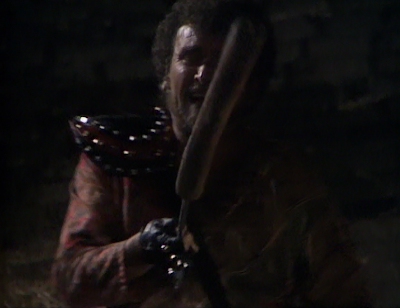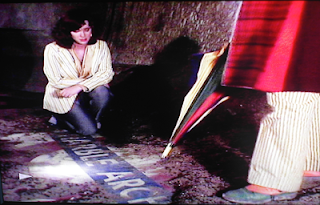 |
| ♫ We're all going on a summer holiday ♫ |
The saddest aspect of the entire Trial arc is that in spite of some clever effects, splendid villainy, memorable scenes and some top-notch performances from Colin Baker, its culmination in 'The Ultimate Foe' falls flat. The trouble is, it just doesn't go anywhere. We effectively have a two-part story whose only revelation is contained in the first ten minutes. After that it's just a series of surreal set-pieces and a finale that just doesn't pay off in any way close to satisfying all that has been built up to that point.
Many fans are quick to lay the blame at Pip & Jane Baker's door. While it is true that they are responsible for some pretty tragic dialogue here, it really wasn't their fault that the story ends so clumsily. The original plan was for Robert Holmes to pen the final two episodes, but he was admitted to hospital after only completing the first - and was sadly never to recover. Eric Saward, script editor and close friend, wanted to remain faithful to the story sketched out by Holmes, but he was countermanded by producer John Nathan-Turner. In a fit of pique, Saward quit and JNT was left trying to piece together a final episode by himself. In his panic, he turned to the Bakers (who had written the previous Vervoid story) and asked that they complete 'The Ultimate Foe'. It's no surprise, then, that the resulting story feels unbalanced and messy. The Bakers had the almost impossible task of wrapping up a massive plot without really knowing much about what had gone before. This, coupled with the fact that JNT was adamant the season go out on a positive note (so as to leave the Beeb without any excuse to can the show yet again), has delivered to Who history a two-parter that promises much but delivers little.
But we won't just dwell on the negatives, because there is plenty to revel in here. First off, we have the wonderful Anthony Ainley beaming down at us from the matrix screen in the court room. His appearance is quite unexpected, and as he puts it himself, he's enjoying himself immensely.
 |
| So are we, Ant. So are we. |
We also have the return of the inimitable Sabalom Glitz, who in many cases steals the show. The scene in which the Master tries to hypnotise him is uproariously funny:
 |
| Worth a few grotzits |
He also manages to get speared by the world's wobbliest harpoon:
 |
| "Help! I'm being attacked by a giant corn dog!" |
Mel is back too, but is criminally underused here. She also has the misfortune to utter the single worst line of the entire story, betraying the Bakers' lack of any technical knowledge.
 |
| A "megabyte modem", apparently. |
It's great that Michael Jayston gets to flesh out his character in the story, and there are plenty of scenes featuring him (thankfully without the peculiar skullcap) and his ability to laugh demonically. The big reveal, if you don't already know, is that he is the Doctor's darker self, an incarnation between his 12th and 13th incarnations. Now, by itself that surely suggests some serious plot developments. It's an intriguing (and chilling) idea, but alas, it receives hardly any attention. Instead the Valeyard is just treated as a run-of-the-mill villain, a bit like the Mind Robber, capable of dealing out illusions but ultimately little more than a dodgy Timelord with a propensity for melodrama.
 |
| Is he dying? No. So why is he keeling over on the floor? |
The thing is, I can see how it should have worked. We've just had three stories, back to back, in which the Doctor has - at various times - revealed a darker, edgier side. Indeed, the Sixth Doctor's entire tenure has been marked by hints of darkness in places. Not only that, but Who has been laid into in the press for being too dark and too violent. Here you can see the writers attempting to address this head on - by conjuring up a Dark Doctor, responsible for the evils the Doctor himself has shown he is capable of. It's a great concept - but by the final episode of 'The Ultimate Foe', nothing happens. He appears to die, then turns up at the end as suddenly having become the Keeper of the Matrix with no apparent explanation as to why. What was originally his plan to take the Doctor's remaining lives ends up being about zapping the court room with a particle disseminator. Why? We're never really told.
On top of all that, we have another classic, senseless Master plot. Apparently, he wants the Doctor to get rid of the Valeyard, because the Valeyard is out to kill the Doctor - and only the Master can be allowed to do that. Except, of course, the Valeyard
is the Doctor, so why doesn't the Master want to kill the Valeyard as well? Furthermore, he has ample opportunity to at least bump off the Sixth Doctor when he's aboard the Master's own TARDIS - but instead he bamboozles him with pretty coloured lights in order to somehow bend him to his will. Really, Master, you've got to up your game.
 |
| "Help, I've lost my bucket and spade!" |
On the effects side, this story is most memorable for the scene in which the Doctor is pulled under the sand by a bunch of disembodied arms. I can remember when I first saw this as a child, I was mortified. It doesn't quite stand the test of time (it's clear that Colin Baker is having to waggle his bum quite a bit to get the process started) but it's still a great scene. Admittedly its foreshadowed by a deeply theatrical sequence in which the Doctor sticks his head into a water barrel having already said aloud that he isn't going to find what he's looking for in there. So why'd you stick your head in there, Doc?
 |
| Happy in his work |
The real-world location for the Fantasy Factory works really well, and the scenes shot in and around it are some of the best for the story. The Dickensian feel suits the story, somehow, and Geoffrey Hughes (Onslow from 'Keeping Up Appearances') as Mr. Popplewick is sublime.
 |
| No string vests today |
He also provides the basis for Doctor Who's first ever 'Mission Impossible' scene:
 |
| The mask was good enough to fool Jane Baker, apparently |
Although it's never fully explained why the Valeyard is pretending to be the secretary of a man who is pretending to be J J Chambers, who is the Valeyard. Who is the Doctor. Doctor Who.
That's enough - Ed.
The dialogue, particularly in the second episode, really lets down the story as a whole. In addition to the infamous "megabyte modem" (or "modum" as Bonnie Langford has it) we also have the "nothing you can do to prevent the catharsis of spurious morality!" howler. Then there's a scene where, having told us the particle disseminator can disseminate sub-atomic particles, the Valeyard proceeds to reel off a long list of all the names of sub-atomic particles ("gravitons, quarks, tau-mesons...") just to prove he knows what they are. It's not all bad, though - Glitz, having been harpooned, has this gem to offer: "Oh, I see! He humiliates you by throwing harpoons at me!" That line always makes me chuckle.
 |
| "J'accuse!" |
The trial-within-a-trial is a good scene, but it fails to add much to the plot overall. The single best scene is the one in which Colin Baker goes full welly with moral indignation at his own people:
"In all my travelling throughout the universe I have battled against evil, against power mad conspirators. I should have stayed here. The oldest civilisation: decadent, degenerate, and rotten to the core. Power mad conspirators, Daleks, Sontarans... Cybermen, they're still in the nursery compared to us. Ten million years of absolute power. That's what it takes to be really corrupt!"
Having demonstrated what an accomplished actor he is here, it's a scandal that Colin wasn't given more dialogue like this to get his teeth into.
For all the intriguing concepts it offers us, the story's greatest crime is failing to follow up on any of them. We never really learn what the Valeyard wants, what his plan is, how he has come into existence, what role the matrix plays in all of it, how much it was tampered with, how the Doctor came to be on trial in the first place, who the 'sleepers' really are, why there is a sudden, unexpected revolution on Gallifrey and what, exactly, was in that waiting room.
 |
| A fire-breathing Skarasen? An angry Myrka? Michael Grade? |
And yet, and yet. In spite of all that, somehow I can't help enjoying this send-off to the Trial story. I love Michael Jayston's performance, the return of Glitz, the peculiar goings on inside the matrix and the gloriously evil Anthony Ainley. Colin Baker is on fine form, the effects are (in places) robust and the ideas that the story throws up are (even if undeveloped) interesting in their own right. I have it on good authority that the Virgin Missing Adventure novel "Millennial Rites" does the Valeyard character far greater justice than the scriptwriters manage here.
What remains to be said? The show, having tried to prove itself to an unremittingly hostile BBC management, had ultimately found itself guilty in the Trial of a Time Lord. Poor Colin was dismissed before the next season began, through no fault of his own, leaving him with "carrot juice, carrot juice, carrot juice" as his last words on screen. His legacy as the Sixth Doctor was marred by the hiatus of the show, the decline in ratings and the failure of the BBC to take its iconic show seriously. In another world, in another time, the Sixth Doctor would have run and run - as he has done in the Big Finish audio plays. For now, though, we bid a fond farewell to Colin Baker and Doctor Six.
 |
The Valeyard, having become the Keeper of the Matrix, has the last laugh.
Not that any of this comes close to making any sense, of course. |































































